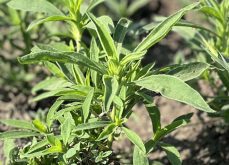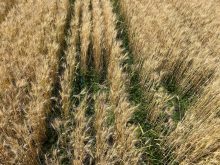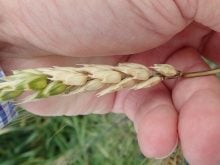The word disease literally means not at ease (dis-ease). For a comprehensive review of all important diseases on the Canadian Prairies look out for the soon-to-be published, revised edition of Diseases of Field Crops in Canada. Crop diseases range from disease-causing fungi, bacteria, viruses and nematodes to nutritional problems.
There are far too many diseases to cover in one write-up on all of our crops from flax to dry beans and alfalfa, so I’ll deal initially with our two major Prairie crops, wheat and canola. Below, I’ve outlined the major diseases of these two important crops.
Read Also

Claas brings 1000 Series SP forage harvesters to Canada
In mid-August, Claas unveiled its new line of Jaguar forage harvesters at an event in Visalia, California, deep in the heart of that state’s dairy region.
Wheat diseases
Prairie-grown wheat suffers from dozens of fungal diseases from seed germination to maturity. These diseases range from seed-borne smuts and bunts to fusarium head blight (FHB) and rusts.
Bacterial diseases are aster yellows and seed-borne bacterial leaf blights.
There are lots of relatively minor virus problems to “highly” destructive virus problems on winter wheats, such as wheat streak mosaic virus.
With respect to nematodes, there are none of consequence in Western Canada yet, but there are nematodes in Montana on wheat. In Ontario, oat cyst nematode is very destructive on all small grain cereals and they even damage corn. Yes, Virginia, nematode diseases are studied by plant disease specialists, not entomologists.
Soil scientists were very slow to recognize non-infectious nutritional diseases due to micronutrient deficiencies in field crops since this scientific aspect was taught to horticulturalists and plant disease specialists. Now we know all about zinc, copper, molybdenum and manganese deficiency problems that can crimp our efforts to optimize crop yields.
Finally, herbicide residues are very important in all crops following drought years.
Canola diseases
Clubroot, sclerotinia and blackleg are the perennial big problem diseases. Aster yellows is sporadic and verticillium wilt, seedling blights and leaf spots also cause yield losses.
Canola diseases: Wet to good moisture conditions
In wet seasons, the above-mentioned diseases, except for aster yellows and seedling blights, are of prime importance.
Clubroot
Under wet or flooded growing conditions in clubroot-infested fields, mobile spores of this fungus move easily through the soil and can infest any member of the canola and cabbage family. This includes susceptible (non-resistant) canola varieties, non-resistant volunteer canola, wild mustard, shepherd’s purse, stinkweed and any and all members of this family.
To control clubroot, plant a clubroot-resistant variety as soon as possible, whether your fields are clubroot-free or you know you have infested fields. If your farm is clubroot-free, do not allow any equipment on your cropland that has not been cleaned with a pressure washer or steam cleaned. The primary way clubroot is spread from field to field is on equipment that has not been sanitized.
If you have clubroot on your land, you must plant resistant varieties of canola and also ensure that if you previously grew Roundup canola varieties, switch to LibertyLink types if your land is clubroot infested or vice versa. On clubroot-free land, grow any canola type as long as it has clubroot resistance. Farm equipment and all vehicles are the primary causes of clubroot spread.
Blackleg
Virulent blackleg comes in several disease-causing strains or types. Almost all blackleg-resistant canola varieties are also resistant to clubroot. Whether you have blackleg-infested cropland or not, you should switch up your blackleg-resistant types. Ask your dealer how to do this. If you grow the same variety year in and year out, you will build up blackleg susceptibility in the canola crop to that particular resistant type. Blackleg is seed-borne as well as stubble-borne. Buildup only occurs in seasons that are wet or have good moisture when plant-to-plant infection takes place. Canola stubble can carry the blackleg fungus for three to five years.
Verticillium wilt
The newest disease problem to show up is verticillium wilt. This disease is common in Europe and the No. 1 disease in canola in Sweden.
Verticillium wilt, which is soil-borne, will be a problem just like clubroot spreading from field to field in wet or dry weather. Lots of mud in wet weather allows this disease to spread more easily from field to field. This fungus survives as microsclerotia, which are tiny masses of small, hard, black cells that can survive for 10 to 15 years. The potential spread of this disease is another good reason to limit entry to your cropland of mud-covered farm machinery used on other farms.
Sclerotinia
Sclerotinia white mould can spread like wildfire in hot, humid, rainy, July weather, when the canola crop comes into full bloom. The moist soil allows the overwintering hard, black sclerotes to germinate at or just under the soil surface. These sclerotes produce countless spores where they may have sat dormant for two years or more.
The spores infect the canola petals, which fall off the canola flowers and lodge in the leaf and branch crotches on the canola stems. These infected petals provide the energy for the fungus to infect the canola stems, killing off canola plants. Neither individual spores nor the sclerotes in the soil can infect canola plants directly. Falling petals that become infected with the sclerotinia spores are the problem. Thus, disease control is done at full bloom in the canola crop when most petals can be covered with a recommended fungicide. Spray when the canola crop is at its yellowest, which is also the time when 30 per cent of the flower buds are open.
Aster yellows
This disease can be equally destructive on canola and wheat, it’s just more obvious on canola. Ten to 50 per cent aster yellows on canola can mean 10 to 50 per cent dead heads in an adjoining field of wheat. Outbreaks of aster yellows are mostly regional and sporadic every five to 10 years. Outbreaks are independent of good soil moisture or drought conditions on the Canadian Prairies.
Wheat diseases: Wet to good moisture conditions
Almost all wheat diseases are problems during wet to good moisture growing conditions. FHB is the No. 1 problem, especially in humid summers. Almost all foliar fungal diseases spread very readily, from tan spot to septoria, to bacterial leaf diseases and all of the wheat rusts.
Fusarium head blight
Under wet conditions, FHB-infected crop residue (wheat, barley, oats, rye, triticale and corn stover) can be a source of infectious spores, which are released under wet or moist, humid conditions. Wheat is most susceptible to FHB just after emergence of the head from the boot. One of many available fungicides at this time can give good disease control.
Foliar diseases
Tan spot of wheat shows up very early and is of particular concern to durum wheat in wet summers. A disease called red smudge occurs on mature grains as a result of tan spot infection. This red smudge downgrades the grain.
This year, three new fungicides were registered for foliar diseases in wheat, along with several others previously registered. One of our major crop protection companies brought out a new fungicide, which is based on new fungicidal chemistry under the brand name Miravis. The Group 7 fungicide Pydiflumetofen is combined with one or more disease control products. Little work has been done on the efficacy of these many foliar fungicides by research organizations on the Canadian Prairies, so it’s not possible to recommend one product over another.
Canola diseases: Dry or drought conditions
Dry seasons underline the importance of the most critical nutrient on the Canadian Prairies — water. When water is low or deficient, crop production goes downhill. Fortunately, most years will be drought-free but not without some drier-than-usual seasons.
Seedling blight
In dry springs, especially when it’s also cold, growers seed for moisture in canola under these conditions. Rhizoctonia seedling blight can be devastating, even with appropriate seed treatments. This fungus can “pinch” the seedling stem, especially for deeper seeding above the treated seed. It’s for this reason it may be better to wait a little later for warmer soil than hurry to be the early bird. In wet springs, warm springs and shallow seeding, rhizoctonia blight is usually absent.
Clubroot
The clubroot fungus spores move poorly in drier soils, and farm equipment is much less likely to carry around packed, wet mud. Although you may not be carrying much soil from field to field, be aware of neighbours or custom seeders and harvesters, which can still introduce clubroot-infected mud onto your cropland. Even if you only suspect there are clubroot-infested fields in your area, it’s time to plant clubroot-resistant canola.
Blackleg
Canola seed may have little or none of the seed-borne blackleg fungus, but seedling infection is not uncommon from May onwards from old, infected canola stubble, which can discharge spores for three to five years. In dry springs and summers, seedlings and growing plants may show little or no infection from this destructive disease. Even so, it pays to change your canola varieties every few years to avoid buildup of specific blackleg-resistant strains on canola.
Verticillium wilt
If verticillium wilt is present on your cropland, it will show up regardless. If you see premature dead or dying canola plants, have them checked by disease specialists. If verticillium wilt is confirmed, you must follow clubroot of canola management practices.
Sclerotinia white mould
In dry summers, especially dry weather in July when the top two to three inches of soil are dry, sclerotinia sclerotes fail to germinate. If no rain occurs until mid- to late July onto dry surface soil, your canola crop will have missed white mould infection. This is not true for dry beans or sunflowers, since sclerotinia sclerotes a few inches into the soil surface can directly infect the roots of these crops.
Sclerotes will not infect canola roots. In dry July weather and dry surface soil conditions, your canola crop should have missed this disease problem.
Wheat diseases: Dry or drought conditions
In dry spring and summer weather, you can expect little in the way of foliar diseases. Both foliar fungal and bacterial diseases need long moist to wet conditions of several days to sporulate and infect healthy dry wheat leaves.
FHB outbreaks on wheat need wet weather in July to induce this fungus to produce aerial conidiospores and ascospores. Dry, windy weather, especially at wheat head emergence, may mean little or no FHB, so fungicide protection may not be necessary.
If you need further information on these major diseases, there are four fact sheets I have written, which may have been revised by others in recent years, with lots of photographs. The Alberta Agriculture fact sheets, which you can download, are listed below.
- Blackleg of Canola, Agdex 149/632-3
- Clubroot Disease of Canola and Mustard, Agdex 140/638-1
- Fusarium Head blight of Barley and Wheat, Agdex 110/632-1
- Disease Forecasting for Sclerotinia White Stem Rot in Canola, Agdex 149/632-4
Please note, we now have much better fungicides available as well as control methods, but the principles and recognition of the destructiveness of these diseases remains an ongoing agronomic problem.
















